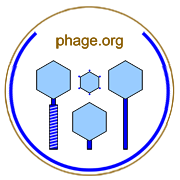

Application of phages to an immature bacterial lawn by dropping a small volume, such as 10 µl, onto the surface of a plate.
Spotting can be used to provide a first approximation of the ability of a phage to lyse or just kill a bacterial strain. This is done such as during phage typing procedures or, at lower phage densities, as a means of phage titering that is less materials intensive than full plate-count assays.
Spotting can be used as a means of determining a phage's host range. It should not be assumed, however, that the reader intrinsically understands that spotting is being employed to determine that phages can kill bacteria since spotting is not the only means by which phage host range can be tested. It also should be strongly kept in mind that spot formation is indicative of the ability of a phage-containing solution to inhibit bacterial growth (that is, lawn formation) rather than an indication that phage infection can occur or even that phage adsorption can occur—that is, other components of phage lysates can also inhibit bacterial growth such as host bacterium-produced antibiotics or bacteriocins.
In fact, among means of phage host-range determination, a spot represents one of the least if not the least informative of measures, tending towards false positives in terms of the degree of phage impact on the bacterium being tested. (Plaque formation, by contrast, tend towards false negatives, i.e., lack of plaque formation even given phage ability to infect and kill host bacteria.)
Formation of distinct plaques within spots can be a reasonable indication that phage growth has occurred, though this phenomenon is not equivalent to the formation of a spot. Depending on the phage titer applied, plaque rather than spot formation may be indicative of low phage efficiency of plating.
Spotting should not be confused with plaquing, even though spotting can be a means of generating plaques. In particular, a spot in which clearing is confluent (effectively no bacteria across the area of the spot) is not a plaque, and this is because while a plaque starts with one or only a few phages and is formed via repeated rounds of phage infection and bacterial lysis, a spot that starts with numerous phages (as is often the case) produces confluent clearing mostly or solely through inhibition of bacterial replication rather necessarily via lysis of an otherwise visible bacterial lawn.
Importantly, "spot" and "plaque" are not equivalent terms – with spots in particular not plaques – and these terms consequently should not be used interchangeably. A spot in particular is much more equivalent to a zone of inhibition, that is, of bacterial lawn formation, than is a plaque.
For more on this topic, see Wikipedia, Google (Alt), and PubMed (Alt). Contact web master. Return to terms.